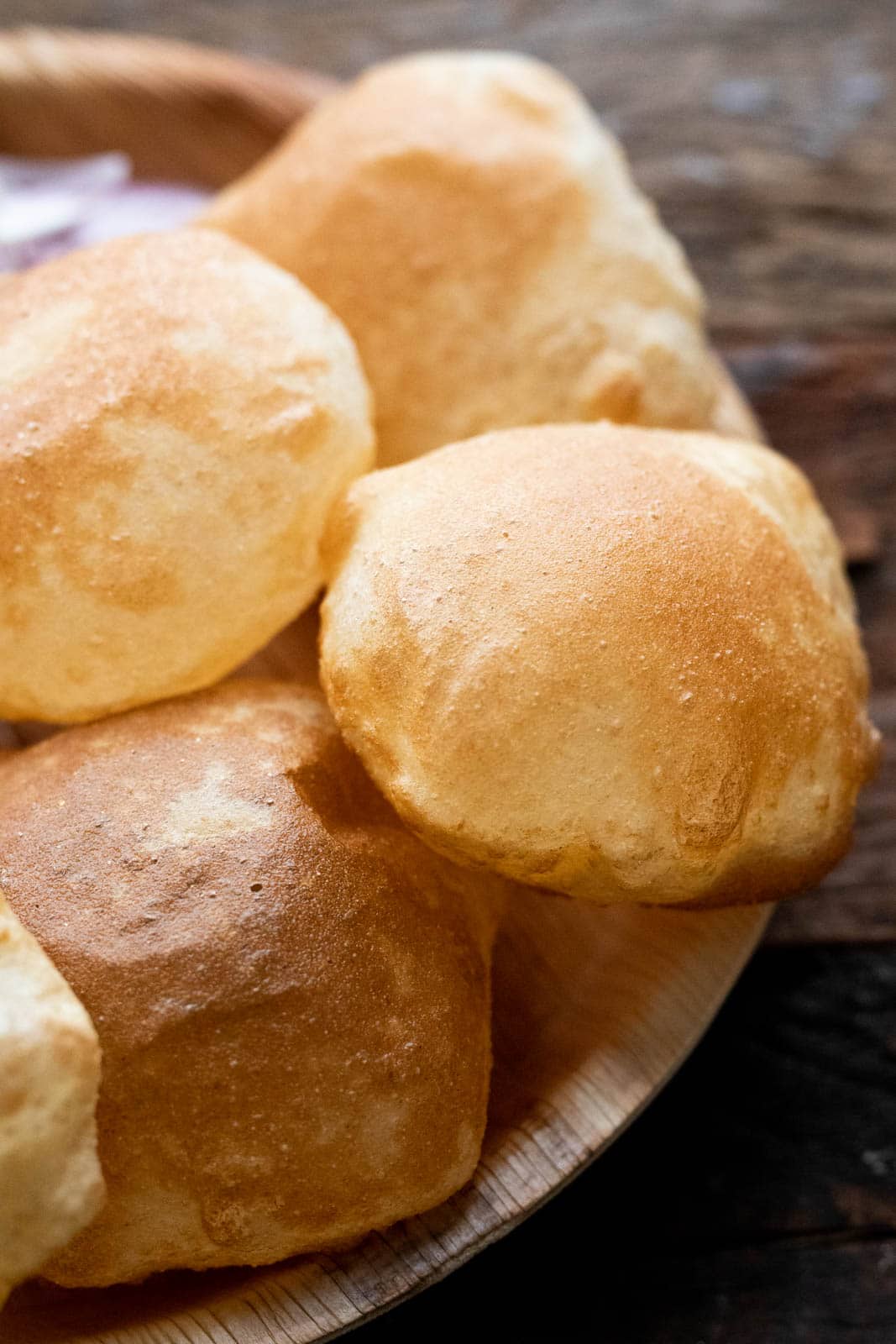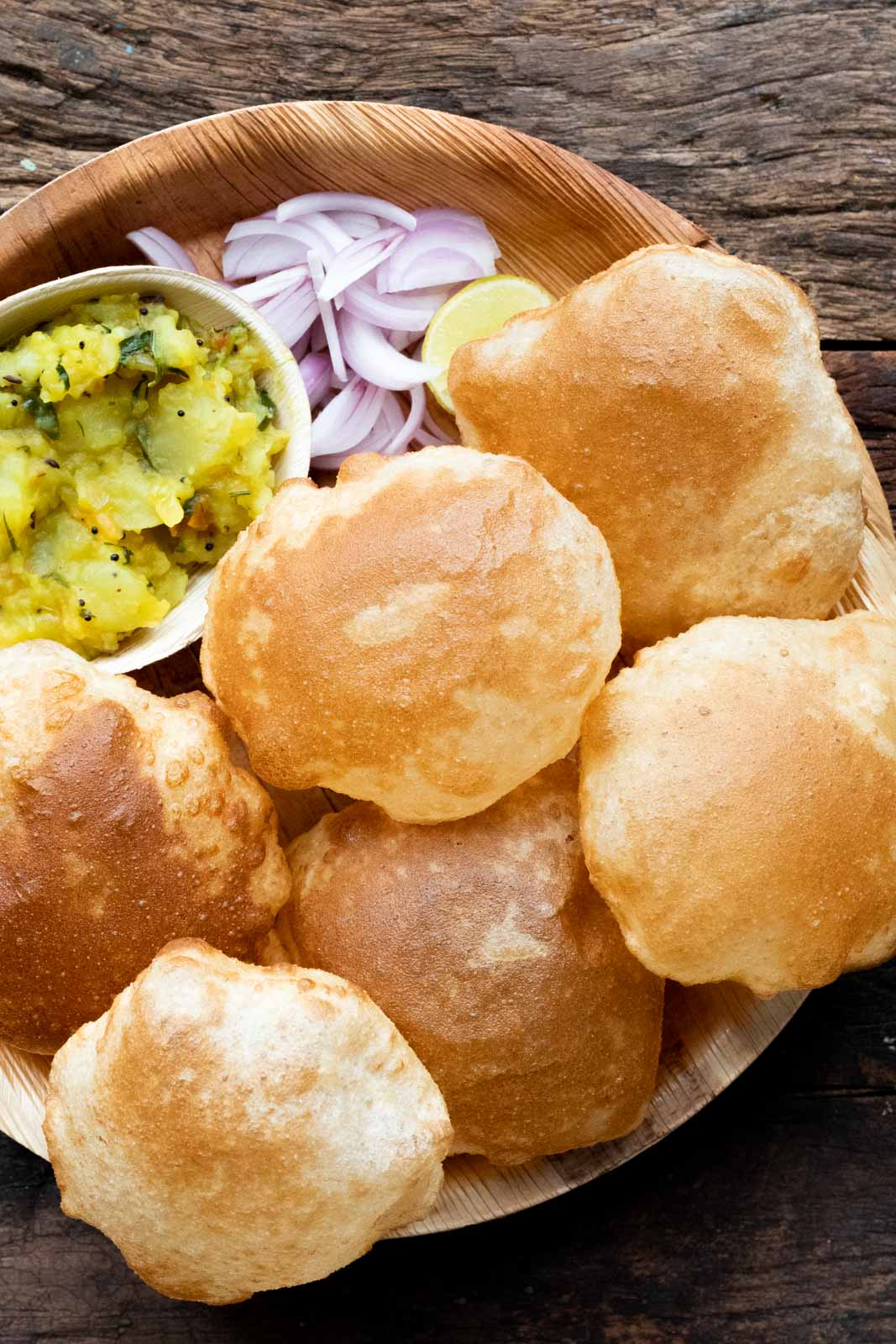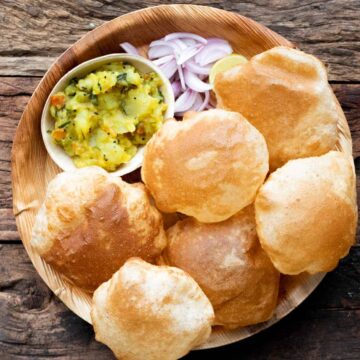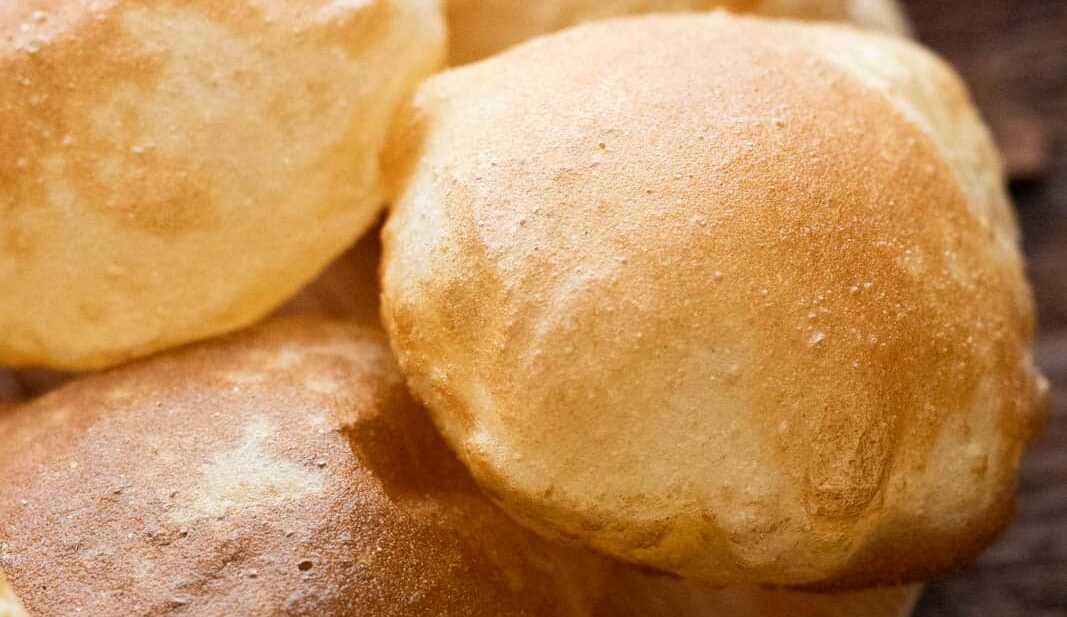Craving fully puffed up crispy pooris but haven’t quite mastered the technique yet? Here’s the Perfect Poori 101 with tips on how to make the dough for poori, how to roll the pooris, best way to fry them, and how to enjoy them!

Is there anything better in life than perfectly puffed up, light as air pooris? Pooris just bring back so many memories for me - my mum gave us kids little balls of dough to play with and we would watch in wonder as the puris puffed up in the hot oil.
I see the same excitement in Mahi now when I make pooris at home. Life's come a full circle 🙂
I’ve been making puris for years now, but I never really paid attention to the finer details. Off late, a lot of you asked me for tips on how to make restaurant style pooris, and that’s when I started recording and testing my puri recipe. We did several trials of this poori and we are super satisfied - They turned out fluffy, crispy, delicious and so satisfying!
Let’s break this down into three important steps to making fluffy, crispy puris
- How to make the Dough + resting time
- How to roll out the puris to ensure the oil remains clean and there are no burnt bits
- How to fry them so they puff up and puris are light, not oily
Quick Walk Through: Perfect Pooris
Dough for Poori
Poori dough is made in the same way as the dough for rotis but with a lot less water. It has a comparatively stiff texture as opposed to the soft dough for rotis.
The two main ingredients for the poori dough are atta (whole wheat flour) and water. You can add a small amount of sooji in this dough. Sooji makes pooris crisper and keeps them that way for longer - most restaurants add some sooji to their puri or bhatura dough. That’s how I’ve shown the recipe in the video, but to be honest, we rarely add sooji to our dough when making puris at home. So you can skip the sooji if you prefer it that way.
There are many cultures in which maida is also added to the puri dough. In Bengal, they are called luchi, but these are different.
The key is to make the dough stiff. It should be kneaded well but without adding a lot of water. The stiff dough is what makes it easy to roll pooris and helps the poori puff up properly.
- If the dough is too dry and doesn’t come together, add water one teaspoon at a time till it comes together
- Once the dough has been kneaded well, add a teaspoon of oil and knead again for a minute or two - this makes the dough smooth
- Also, poori dough shouldn’t be rested for too long - just five to ten minutes will do
Rolling out Pooris
Ideally puris should be round or oval in shape, but there is no judgement here. Even after years of practice, sometimes I still dish out puris in all sorts of shapes.
- In the video below, I’ve demonstrated how to make puris which are roughly the size of my palm. The thickness of the poori should approximately be about 1 mm (shown in video). If they end up being too thin, they won’t puff up properly. Too thick and they won't cook well.
- Dip the ball of dough in a tiny amount of oil before rolling it out. The oil helps grease the dough and makes it easier to roll them out without sticking. Avoid using dry flour to dust puris (like we do for rotis). When dry flour comes in contact with hot oil, the flour particles will just burn and leave burn bits in your oil. And that’s an unpleasant taste. It’s important that the oil remains clean as we fry the puris.
- Pooris are such a fun food experience for kids! So if you have kids to entertain, don’t hesitate to use a cookie cutter on your rolled out dough and make fun-shaped puris for the kids!
How to Fry Fluffy Crispy Pooris
There are a few technicalities involved in the poori-frying process. Here’s a quick checklist before you begin:
- Oil temperature: The pooris should be fried in hot oil to keep them from getting too oily or soggy. Do a temperature test in the beginning by putting a tiny piece of dough in the oil - it should sizzle and come to surface immediately. You can also add a pinch of salt to the oil which prevents puris from becoming oily
- Best Oil for frying puris: Since pooris need to be fried in very hot oil, use oils with a high smoke point such as sunflower oil or rice bran oil. These will not smoke easily and will keep the oil clean
- Dropping the poori: Don’t just plop the rolled out poori flat onto the oil - Dangerous! The trick is to hold the poori vertically above the kadhai and gently slip it into the oil from one side.
- The fluff factor: Super crucial step - When the poori starts sizzling, pick up your skimmer and gently press the poori into the oil. As soon as the puri starts puffing up, turn it over and press it gently again from the other side. In a few seconds, the poori will start to become golden brown - that's when it's time to remove them. Each poori should take about 20-25 seconds to cook. You can roll them out before hand and fry them one after another. Or if you have someone to help you, you can fry them as and when they are rolled out.

Best accompaniments for Poori
Here’s a list of our favourite accompaniments for pooris! Some of these are super popular, some are an acquired taste! Here’s a list of side dish options to serve with your pooris:
- Chana Masala - The best, spicy, north Indian dish to go with pooris - work up your appetite before this heavy meal
- Poori Bhaji - Simple potato-veggie-loaded bhaji and poori - all time favourite
- Poori Aloo - Ignore the carbs and dig into this sinfully satisfying dry side dish made of aloo, onions, peas, etc.
- Poori Chutney - In south Indian restaurants, poori is served with coconut chutney, and it is so addictive!
- Poori Korma - A richer variant of poori bhaji, this veggie korma one is for special occasions
- Poori Aamras - This combo is soooo underrated! When mango season is on, this is literally all we eat!
- Poori Shrikhand - Sweet and so delicious, this one is for all those with that insatiable sweet tooth
- And if you are craving pooris but don’t feel like making an accompaniment, grab that bottle of achar and a bowl of raita, and tuck in!
If you found my technique of making fluffy and crispy pooris helpful, do leave a comment below!
Watch How to make the Perfect Pooris

How to make the Perfect Pooris
Ingredients
- 2 cups Whole Wheat Flour
- ½ tablespoon Sooji (optional)
- ½ teaspoon Salt
- ½ cup Water + extra if required
- 1 ¼ teaspoon Oil for the dough
- 1 ½ -2 cups Oil for frying (see note 2)
Instructions
- Mix together flour, sooji and salt in a bowl and add half cup water a little at a time to make a stiff dough. If the dough is too dry and doesn’t come together, add more water a teaspoon at a time. The dough should be stiffer than roti dough, and should not be too pliable. At the same time, you shouldn't see any dried bits of dough. Once the dough has been kneaded well, add 1 ¼ teaspoon oil and knead again for a minute or two to get a smooth dough. Cover this with a cloth and set this aside for 5-10 minutes.
- Once the dough has rested, roll it into a log and divide it into small gooseberry sized balls (slightly smaller than limes). Roll each piece of dough into smooth balls and then press it slightly. Repeat this till all the balls are formed and cover and set them aside.
- Heat oil in a kadhai or deep pan for frying. To roll out the pooris, take one ball, dip it slightly in oil and roll it out into a circle to 1 mm thickness. Don't worry if you don't get the perfect circle - just make sure it's evenly rolled.
- Make sure the oil is very hot. To check, take a small pieces of dough and put it in oil. If it sizzles immediately to the top, the oil is ready for frying.
- Take the rolled out dough, hold it vertically above the oil near the edge of the kadhai and gently slide it in (don't plop it in or the oil will splash back). The puri should immediately sizzle to the top. Start pressing it with the back of the spoon and as soon as it starts to puff up, flip it over gently. Keep pressing it gently as it puffs up. Once the puri is golden brown from the bottom, take it out. Repeat this till all the puris are fried.
Video
Notes
- Add ¼ teaspoon to the oil to the dough if you'd like. This keeps the pooris from becoming oily
- The best oils for frying pooris are sunflower oil and rice bran oil because they have a high smoke point
- Make sure the dough is rolled out evenly
- Semolina or sooji is an optional ingredient in pooris - it helps them become crisp and stay crisp for longer. I've used it in the video but don't generally use it while making them at home


indiandesitadka.com says
Indian food in Calgary
Alice says
Best recipe ever, very well explained.My pooris turned out soft& fluffy. yes I will always use this receipe, so thank you.
Richa says
Thanks so much Alice
Wendy says
Richa; wow! that last! I have to make them, the video is just perfect and I wait for you to tell me the temperature of the oil and ready to fry them ha ha ha. Yeah, I'do not fried to much, but when I do, I use a thermometer, there is no fear of error. Thanks in advance. Greetings from Spain
Jonathan says
I'd love to know this as well! Thank you!
Richa says
The temperature of the oil should be around 370F
Rabina says
Excellent recipe and i highly apprecited your quality of video , keep it up dear .
Richa says
Thank you so much